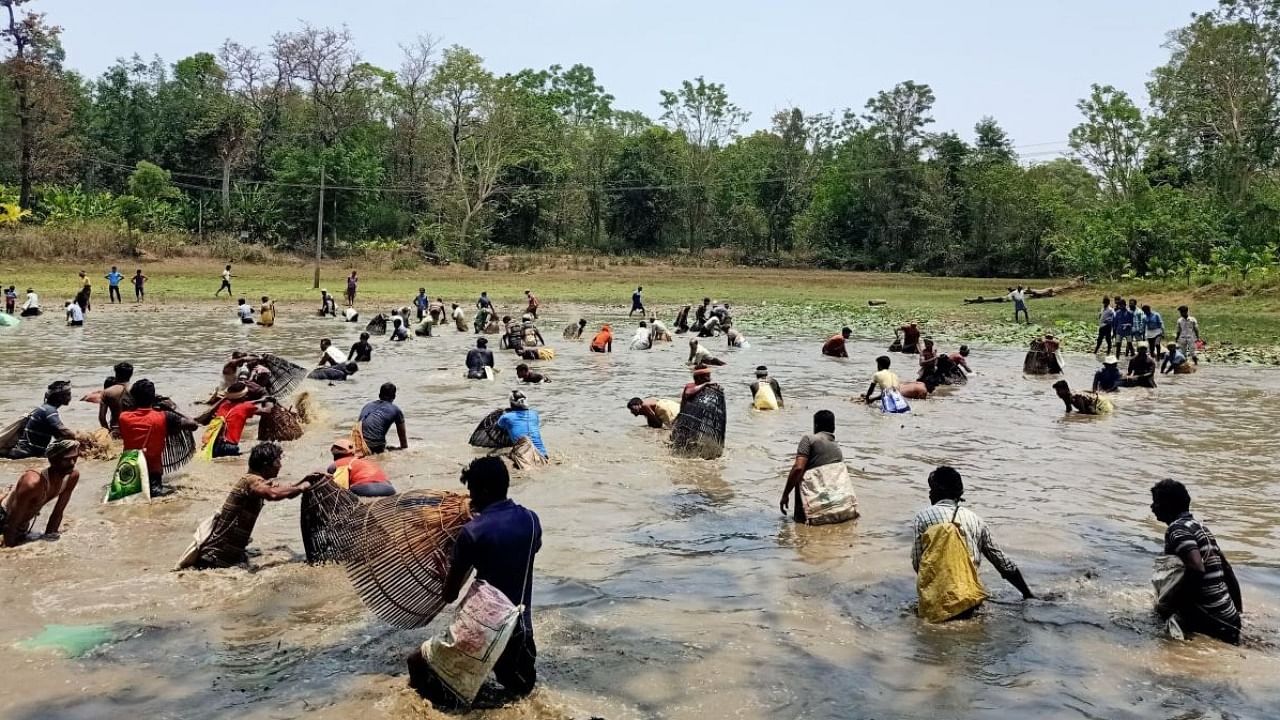
It is midday and a tiny village near Sirsi called Kalkardi, is brimming with palpable excitement. People from surrounding villages have gathered near the village lake in droves.
And then goes the whistle. Some 350 people, both young and old, rush into the lake bed at once amid ooohs’, aaahs, whistles and cheers.
Clad in half pants while holding a kuni and a bag slung down the waist, these men are trying their best to spot fish in the half-dried lake. They are not catching fish for food but ‘hunting’ it for recreation. The one who gets the best catch is named the ‘hero’ of the day.
Come March and events like kere bete (hunting in a pond) or matsya bete (fish hunt) are commonly seen in parts of Uttara Kannada, Shivamogga and Haveri districts. These events are usually arranged between March and May when little water is left in the lake. It is mainly organised in Malnad and semi-Malnad areas of Sirsi, Mundgod, Siddapur, Sorab and Hangal taluks. Farmers who toil the entire year in their fields take some time out of their busy schedule and engage in traditional mass fishing, which is a kind of rural sporting event.
“Just like urbanites go to swimming pools to beat the heat, we villagers spend time in the lake and have fun with our friends during kere bete”, says Basavaraj of Kyadagikoppa village who regularly participates in such events.
Santosh from Kalkardi explains that the practice of kere bete has been around for several decades. Why and when the event began remains a mystery.
The village fish hunt organising committee usually takes charge of the lake in an auction conducted by the gram panchayat. They then buy about 35,000 fishlings (based on the size of the lake) to introduce into the lake. They nurture these fish for a year or two. Once the lake has sufficient fish and lesser water, they organise kere bete event. The hosting of the fish hunt depends on many factors including if the water levels in the lakes have reduced and if the lake has enough fish. If the conditions are not met, the village skips the event. A village will typically host a kere bete once in two years.
The committee then charges an entry fee for each participant. The amount collected is used for development works in the village.
“Each event sees no less than 300 participants. And people from all communities participate even if the amount is going to be used for religious welfare activities,” adds Santosh.
The equipment
Another special feature of the kere bete is the use of traditional fish hunting equipment called the kuni instead of a hook or net.
“Kuni is a series of bamboo sticks stitched together in the form of a cone with a small opening at the top enough for a hand to enter in. The bottom opening is two to three feet in diameter and this part is forced into the lake bed to find some fish. As soon as a fish gets stuck in the basket, players pick it from the cone and put it into their bags,” says Raghavendra Naik of Kiravatti, a farmer and kere bete enthusiast.
He adds that only people of the Medar communities in these areas prepare these kunis.
Women also participate in the event but they use a mankari which is a variant of the kuni.
So, is this a competition? No, it is just a game. The player uses the fish as they wish and a count on the number of fish caught is not maintained. But in most of homes, women wait for fresh lake fish to feast on.
“Usually, fish like gowri, catla are introduced into the lake. The catch depends on the lake area and number of participants. However, the excitement that lies in hunting the fish is more important than numbers. Some participants may be lucky enough to get good number. Some may not get even one,” says Basavaraj.
The event goes on for three to four hours or until the players are willing to continue. There are hundreds of people watching the event with the same eagerness as the players, enjoying the participants’ strategy to catch the fish.
Watch latest videos by DH here: